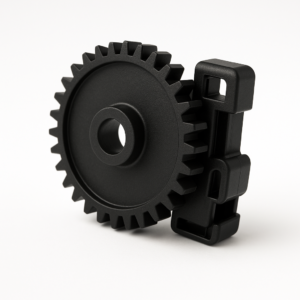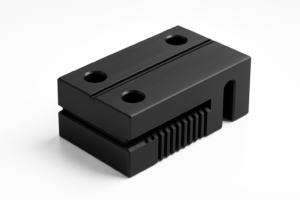Polyoxymethylene (POM)
Polyoxymethylene (POM), also known as acetal or polyacetal, is an engineering plastic that has played an important role in various industries since its introduction in the 1960s. Thanks to its excellent mechanical properties, such as high strength, rigidity, and abrasion resistance, as well as its good chemical resistance, POM has a wide range of applications in mechanical engineering, the automotive industry, electrical engineering, and many other areas. Below you will find an overview of all relevant information, such as production, advantages and disadvantages, manufacturing methods, and differences compared to other engineering plastics.

Structure and composition of POM
Polyoxymethylene (POM) is an engineering thermoplastic composed of repeating oxymethylene units (–CH₂O–). This linear, crystalline structure gives POM its outstanding rigidity, dimensional stability, and abrasion resistance, making it ideal for precision components.
POM is produced by the polymerization of formaldehyde or trioxane using anionic or acid catalysis processes. This results in two main types:
POM-H (homopolymer) is produced directly by the polymerization of formaldehyde and is characterized by high crystallinity and stiffness.
POM-C (copolymer) is produced by copolymerization of trioxane with small amounts of comonomers, which improves thermal stability and hydrolysis resistance.
These manufacturing processes make it possible to tailor POM to specific areas of application, particularly for components that require high precision and dimensional stability under mechanical stress.
Main advantages of POM

Precision and versatility
POM can be precisely processed into complex technical components and is used in numerous applications, from mechanical engineering to medical technology.

High dimensional stability
Thanks to its high rigidity and dimensional stability, POM retains its shape even under mechanical stress, making it ideal for gears, bearings, and housings.

moisture resistance
POM absorbs very little moisture, which means that it reliably retains its dimensions and mechanical properties even in humid environments.

Good surface quality
Components made of POM are characterized by a high-quality, smooth surface that offers good sliding properties and is easy to clean.
Processing techniques for POM
Injection molding
POM is an excellent injection-moldable engineering thermoplastic and is used in particular for the series production of precision components such as gears, plain bearings, housings, and valves. Both POM-H (homopolymer) and POM-C (copolymer) are suitable for injection molding, although POM-C has higher thermal stability against hydrolysis, making it easier to process. The recommended cylinder temperatures are approx. 190–210°C, depending on the type and manufacturer's specifications, this can also be up to 230°C. The mold temperature should be between 60–100°C, with higher mold temperatures promoting improved surface quality and dimensional accuracy. The injection pressure is typically between 800 and 1200 bar. After injection molding, the parts should be cooled in a controlled manner to minimize stress and warping. POM can also be injection molded with glass fibers or PTFE additives to optimize stiffness, abrasion resistance, or sliding properties depending on the application.
Extrusion
POM can be processed using extrusion, particularly for the production of rods, sheets, profiles, and film strips for machining blanks. The extrusion of POM requires precise process control in order to achieve a homogeneous melt and the required crystallinity. The cylinder temperature profiles range between 170–200°C, with moderate shear preferred to avoid thermal decomposition. The mold temperatures are typically between 80–120°C. The extruded semi-finished products are characterized by high strength, rigidity, and excellent dimensional stability and are ideal for further machining. Due to their low water absorption, the dimensional stability of the extruded products is maintained even under changing climatic conditions.
Machining
Since POM is extremely easy to machine, machining (turning, milling, drilling) is a widely used manufacturing method, especially for prototypes or small series with tight tolerances. Machining can be carried out with standard HSS or carbide tools. Coolants are usually not essential, but can be used to optimize surface quality and heat dissipation. Due to its low tendency to form burrs and good chip breaking properties, POM is ideal for precision parts such as gears, sliding elements, and valve components. However, when machining POM, the springback effects (dimensional change after machining) should be taken into account, which is why post-tempering is often recommended to reduce stress.
Areas of application for POM
Automotive industry
POM is a key material in the automotive industry and is used for precise, resilient components such as fuel caps, window regulator components, door locks, sensor and pump housings, and sliding and guide elements. Thanks to its high strength, rigidity, abrasion resistance, and good chemical resistance, POM is ideal for applications in the interior, powertrain, and fuel and cooling systems. POM also offers low water absorption and excellent dimensional stability, enabling it to function reliably even under changing climatic conditions.


Consumer goods
POM is used in many everyday and consumer products where precise fits and long-lasting resilience are important. Typical applications include gears in kitchen appliances, plain bearings in household machines, snap fasteners, writing instruments, zipper parts, and razor components. Due to its high abrasion resistance, low friction, and good surface quality, POM is particularly suitable for moving parts in consumer products that must remain quiet and functional over time.
Industry and mechanical engineering
In industry and mechanical engineering, POM is used for slide guides, gears, bearings, valves, pump parts, and precision technical semi-finished products. POM is ideal for components that need to function with permanent dimensional stability and low friction, even with little lubrication or dry running. Thanks to its chemical resistance to many oils, fuels, and solvents, POM is also used for parts in food technology, medical technology, and automated systems. POM is available in the form of rods, sheets, and profiles for machining and is used there as a material for precise, highly stressed parts.

Comparison of the mechanical and chemical properties of POM-C, POM-H, and POM with 25% GF
Polyoxymethylene (POM) is available as a homopolymer (POM-H), copolymer (POM-C), and in glass fiber-reinforced form, and differs in its mechanical and chemical properties. POM-H is characterized by high stiffness and strength, while POM-C offers slightly lower stiffness but better chemical resistance and higher elongation at break. The melting point of POM-H is around 175°C, while that of POM-C is around 165°C. Both types absorb very little moisture, ensuring good dimensional stability even in humid environments.
Glass fiber reinforced POM has significantly higher stiffness and tensile strength, making it attractive for components subject to high loads. However, it is more brittle and has significantly lower elongation at break. The coefficient of sliding friction is slightly higher than that of unreinforced POM, which should be taken into account in sliding applications. In terms of chemical resistance, POM-H and POM-C are highly resistant to many chemicals, while the glass fiber reinforced variant is slightly less resistant but more mechanically resilient.
| Characteristic | POM-H (homopolymer) | POM-C (copolymer) | POM with 25% GF |
|---|---|---|---|
| Density [g/cm³] | 1.41 | 1.39 | 1.50 |
| Tensile strength [MPa] | 65–75 | 60–70 | 95–110 |
| E-Modulus [MPa] | 2800–3200 | 2500–2900 | 6000–8000 |
| Elongation at break [%] | 20–40 | 30–60 | 2–4 |
| Melting point [°C] | 175 | 165 | ca. 170 |
| Water absorption (23°C, sat.) [%] | 0.8 | 0.4 | 0.3 |
| Coefficient of sliding friction (dry) | 0.2–0.35 | 0.2–0.35 | 0.3–0.4 |
| Chemical resistance | Very good | Very good | Good |
| Processability (injection molding) | Good | Very good | Medium |
POM-C is particularly advantageous in processing, as it is easier to injection mold and offers greater dimensional stability. POM-H offers better mechanical properties, but requires more precise processing. Glass fiber-reinforced POM is more demanding to process, but is used when high rigidity and strength are required, for example in heavily loaded gears or precision parts.
All technical advantages at a glance

High strength

High abrasion resistance

Excellent dimensional stability

High chemical resistance

Thermal stability

Good gliding and emergency running properties

High machinability

Cost-effective with high precision
Suitable manufacturing processes
Further materials
Book personal meeting
Contact us now
* By submitting the form, you agree to the assemblean privacy policy.
All information is provided without guarantee. Subject to typographical errors, mistakes, and changes.





